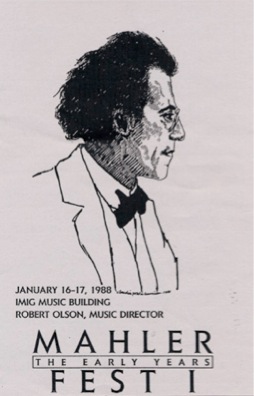There were many reasons to not do a MahlerFest, versus the many “Mozart” or “Bach” festivals, that require a small number of orchestral players. But a Mahler Festival? If it were to survive into the second year, to perform the Resurrection Symphony, almost 300 performers would be needed! The concept began to crystallize; the orchestra would have to be volunteer, because it would be impossible to find the funds to pay over 100 musicians each year. Olson chose the first week in January because it was between semesters at CU, and a slow time in the local arts calendar. He was confident of recruiting enough musicians to do the First Symphony, especially since he had astutely programmed the same piece a month earlier for the community orchestra he conducted, the Longmont Symphony (LSO). He reasoned that if he couldn’t recruit enough area players, he could simply ask LSO to perform Mahler’s First again. In addition, as a conductor at the University, he had an additional pool of talented players he could call upon, if needed.
 From the beginning, Olson was adamant that the festival be multi-faceted in concept, including chamber and orchestra concerts, lectures by experts on Mahler and the general art scene of the turn of the twentieth century in Vienna, Mahler-related films and videos, and, as it turned out, also drama and ballet.
From the beginning, Olson was adamant that the festival be multi-faceted in concept, including chamber and orchestra concerts, lectures by experts on Mahler and the general art scene of the turn of the twentieth century in Vienna, Mahler-related films and videos, and, as it turned out, also drama and ballet.
On a November day in 1987, Mr. and Mrs. Stan Ruttenberg were startled to open the local newspaper and read: “MahlerFest I, January 16-17, 1988, at the CU music building”. Skeptical, but excited, they could hardly wait to see if it would really happen!
The magical weekend actually arrived, and the Ruttenbergs witnessed an exciting set of concerts. The program for January 16 included a lecture by Professor Steven Bruns, of the CU faculty, on “Mahler, the Early Works,” followed by performances of the Piano Quartet, and the Lieder und Gesange auf der Jugendzeit. The next day’s orchestra concert included the First Symphony and Lieder eines fahrenden Gesellen. Though not without problems, the performances were spirited, the audience was wildly enthusiastic, and the press was kind.
Little did the audience know what Olson was going through to make the festival happen. Without assistance, he recruited the orchestra, soloists, and lecturers, wrote press releases, printed the program, and even bought snacks for the orchestra’s final dress rehearsal. As he was walking on stage to begin the first concert, Olson realized that, being also the lighting and stage manager, he had forgotten to dim the house lights and brighten the stage lights. He turned around, ran around the building to the lighting panel, changed the lights, ran back to the stage, and proceeded, completely out of breath, to begin the concert, simultaneously promising himself, “This will NEVER happen again!” The total budget for the first year was $431.00. The concert, lectures, and film showing were all free to the public.
